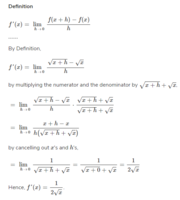You are using an out of date browser. It may not display this or other websites correctly.
You should upgrade or use an alternative browser.
You should upgrade or use an alternative browser.
Sqrt (x) derivative by first principles
- Thread starter apple2357
- Start date
willyengland
New member
- Joined
- Jun 13, 2019
- Messages
- 33
We can't actually substitute h=0 into the expression,
Why not? We are not dividing by zero or anything.
willyengland
New member
- Joined
- Jun 13, 2019
- Messages
- 33
Strictly speaking you should not write:
[MATH] \lim_{h \to 0} \frac{1}{\sqrt{x+h}+\sqrt{x} } = \frac{1}{\sqrt{x+0}+\sqrt{x} } [/MATH]
but only:
[MATH] \lim_{h \to 0} \frac{1}{\sqrt{x+h}+\sqrt{x} } = \frac{1}{2\sqrt{x}} [/MATH]
[MATH] \lim_{h \to 0} \frac{1}{\sqrt{x+h}+\sqrt{x} } = \frac{1}{\sqrt{x+0}+\sqrt{x} } [/MATH]
but only:
[MATH] \lim_{h \to 0} \frac{1}{\sqrt{x+h}+\sqrt{x} } = \frac{1}{2\sqrt{x}} [/MATH]
Harry_the_cat
Elite Member
- Joined
- Mar 16, 2016
- Messages
- 3,779
Here's a question:
What is lim (x->0) 2x +3 ?
What is lim (x->0) 2x +3 ?
Here's a question:
What is lim (x->0) 2x +3 ?
This feels much simpler, I recognise it and know that there is nothing unusual about it, it's linear etc. But thats not the case for the expression involving reciprocal square roots above.
HallsofIvy
Elite Member
- Joined
- Jan 27, 2012
- Messages
- 7,760
You thought wrong. For any function that is continuous at x= a, \(\displaystyle \lim_{x\to a} f(x)= f(a)\).No, but i thought when we take a limit we never actually substitute h=0, we let h tend towards zero which is subtly different?
(That's pretty much the definition of "continuous".) And as long as we have no square roots of negative numbers or divisions by 0 a function like this is continuous. It's only when we have square roots of negative numbers or divisions by 0 that we have to be "subtle".
Dr.Peterson
Elite Member
- Joined
- Nov 12, 2017
- Messages
- 16,870
How about any place earlier than the penultimate line in the proof you are asking about?
As you were told, if a function is continuous, you can substitute; you can't substitute when it is not continuous, and in particular when it isn't even defined there.
In many instances of working out a limit, the process amounts to rewriting and simplifying until you get a new function that is equal to the original everywhere except the place where it previously was undefined, but now is defined and continuous there. Then you can substitute.
As you were told, if a function is continuous, you can substitute; you can't substitute when it is not continuous, and in particular when it isn't even defined there.
In many instances of working out a limit, the process amounts to rewriting and simplifying until you get a new function that is equal to the original everywhere except the place where it previously was undefined, but now is defined and continuous there. Then you can substitute.
HallsofIvy
Elite Member
- Joined
- Jan 27, 2012
- Messages
- 7,760
Let f(x) be defined as "f(x)= 3x if x is not equal to 2 and f(2)= 0". Substituting" 2 for x gives 0 but the limit is 6.Thanks! Can you give me an example where a limit exists but substituting would be wrong?
Or let f(x)= sin(x)/x. Substituting 0 for x gives the "indeterminate" 0/0 but the limit is 1.
Or let f(x)= 0 if x< 1, f(x)= 5 if $x\ge 2$. Substituting 1 for x gives 5 but there is no limit.

